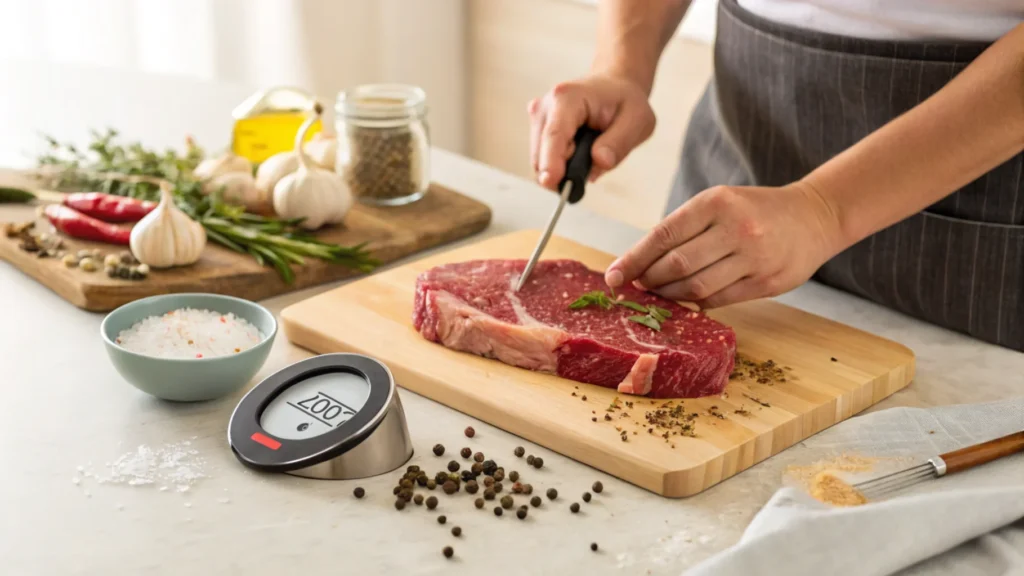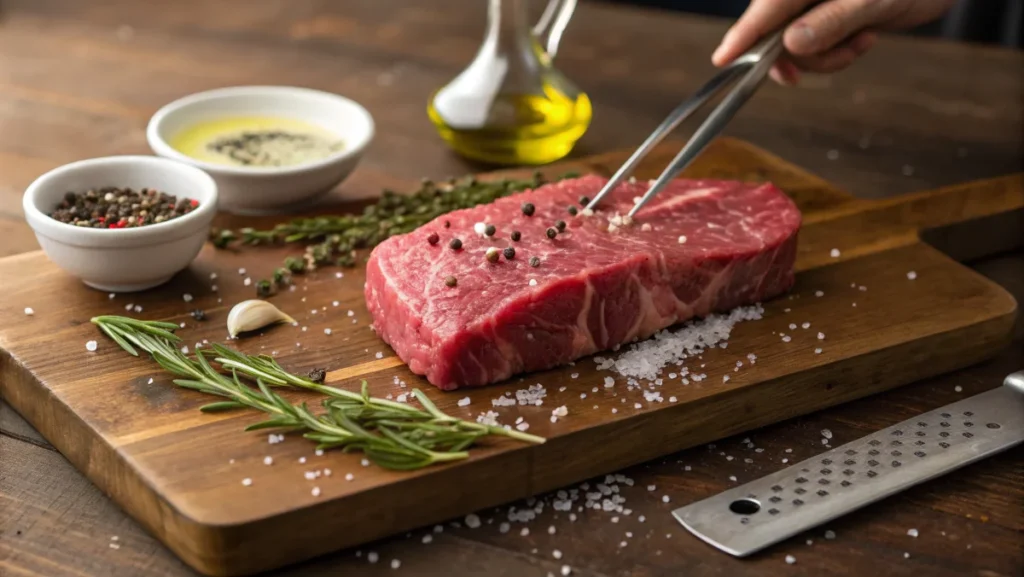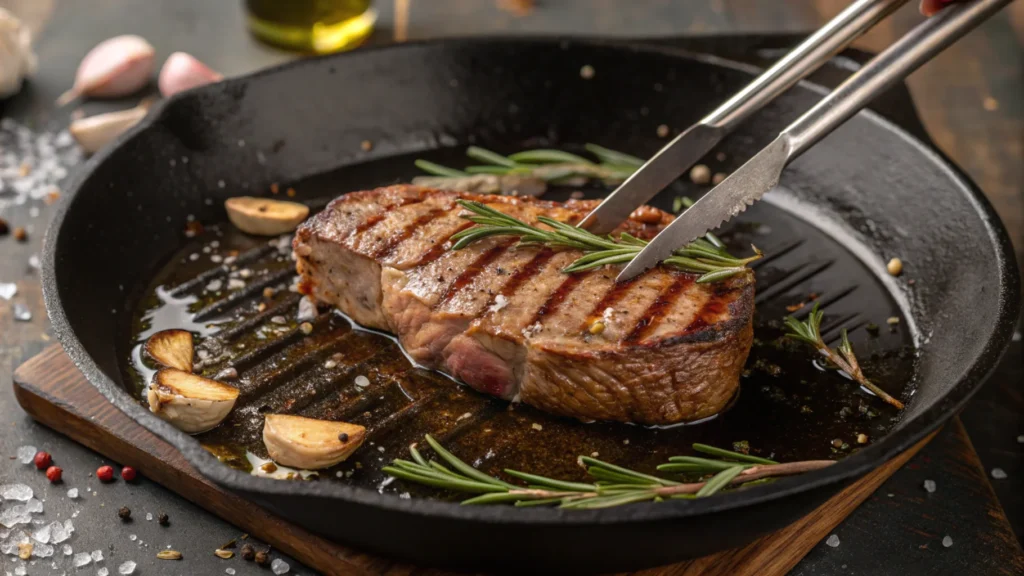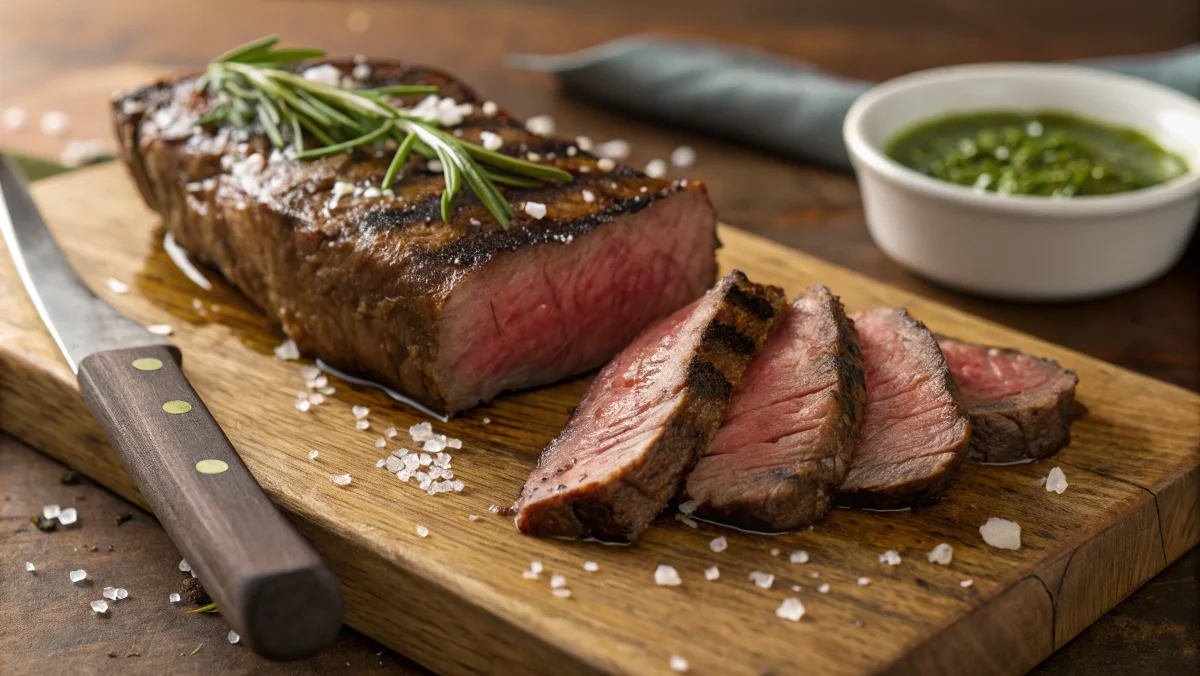Flat iron steak, a tender and flavorful cut from the cow’s shoulder, is a favorite among steak enthusiasts for its rich marbling and fine texture. Comparable in taste to premium cuts like ribeye or tenderloin but more affordable, it offers excellent quality and value. Its versatility makes it ideal for various cooking methods, from grilling to pan-searing, allowing home cooks to achieve restaurant-quality results with ease.
When prepared correctly, flat iron steak delivers a savory and satisfying flavor that complements many dishes. For a refined and impressive meal, try recipes like Individual Beef Wellington, which showcase the elegance of beef in a classic preparation.
How to Choose the Best Flat Iron Steak
When selecting the perfect flat iron steak, several factors must be considered to ensure quality and taste. First, you should always look for steaks with even marbling—this refers to the thin streaks of fat running through the meat. Marbling is essential because it contributes to the flavor and juiciness of the steak.
Next, check the color of the meat. A fresh steak will be a deep red with minimal brown spots. Additionally, make sure the butcher cuts the meat from the top blade section, which is known for its superior tenderness. Here are some other tips:
- Choose a cut that is about 1 to 1.5 inches thick for optimal grilling or pan-searing.
- Check for freshness by feeling the meat; it should be firm to the touch.
- Consider the source of the beef. Grass-fed steaks tend to have a different flavor compared to grain-fed, so choose based on your preferences.
With these factors in mind, selecting the best cut of steak for your needs will be easier and more rewarding.

Preparing Flat Iron Steak for Cooking Success
Proper preparation is key to achieving a tender, flavorful flat iron steak. Whether you’re grilling, broiling, or pan-searing, the right steps can make all the difference. Preparation doesn’t stop at seasoning—properly handling the meat before cooking is essential for success.
Tools and Ingredients You’ll Need
To start, you’ll need some basic tools and ingredients. Here’s a list to get you ready for cooking this cut of beef:
Essential Tools:
- Sharp knife for trimming or portioning
- Grill or skillet depending on your preferred cooking method
- Tongs to handle the steak safely
- Meat thermometer for precise doneness
- Cutting board for resting the meat after cooking
Ingredients for Marinating or Seasoning:
- Olive oil or vegetable oil for seasoning
- Kosher salt and freshly ground black pepper
- Fresh herbs such as rosemary or thyme for additional flavor
- Your favorite steak marinade (or ingredients like garlic, lemon juice, balsamic vinegar, or Dijon mustard)
By gathering these tools and ingredients, you’ll be set for success in preparing a flavorful, tender flat iron steak.

How to Trim Flat Iron Steak
While butchers generally prepare flat iron steak well, trimming it further can enhance its flavor and presentation. To trim the steak:
- Remove any excess fat: The fat around the steak should be minimal. You want to leave a thin layer for flavor but avoid large, chewy sections of fat.
- Cut any connective tissue: Look for any silver skin or connective tissue along the edges of the steak. This can affect texture, so it’s best to remove it.
- Rest the steak: Let the steak rest for about 10-15 minutes at room temperature before cooking. This helps the meat cook evenly.
Proper trimming ensures a clean, flavorful, and tender steak with each bite.
The Best Marinades for Flavorful Steak
Marinating steak boosts its flavor and tenderness. Additionally, it enhances the meat with different flavors. Here are some popular marinade ideas:
- Garlic and Herb Marinade: Mix olive oil, garlic, fresh rosemary, thyme, and lemon juice.
- Balsamic Vinegar Marinade: Combine balsamic vinegar, honey, soy sauce, and crushed garlic for a sweet-savory marinade.
- Spicy Chipotle Marinade: Blend chipotle peppers in adobo sauce with lime juice, cumin, and smoked paprika for a smoky heat.
- Classic Soy and Ginger Marinade: Soy sauce, ginger, garlic, brown sugar, and sesame oil create a rich, savory flavor.
Allow the steak to marinate for at least 30 minutes, but ideally for 2-3 hours, to achieve the best results. Don’t marinate too long, as the acidity can break down the meat too much.
Top Cooking Methods for Flat Iron Steak
When it comes to cooking this cut of beef, there are several methods to choose from, each delivering a slightly different result. Below are the top methods for cooking this steak.
Grilling
Grilling is one of the most popular methods for cooking flat iron steak, and for good reason. It imparts a smoky flavor and creates a beautiful char on the meat. Additionally, this cooking technique helps to seal in the juices, making the steak tender and flavorful.
Here’s how to do it:
- Preheat your grill to medium-high heat.
- Season the steak with salt, pepper, and your favorite seasoning.
- Place the steak on the grill and cook for about 4-5 minutes per side for medium-rare.
- Use a meat thermometer to check the internal temperature.
Grilling allows you to get a perfectly seared exterior while keeping the inside tender and juicy.
Pan-Searing
Pan-searing is another excellent way to cook steak, especially if you’re looking for a crispy, caramelized exterior. Here’s how to do it:
- Heat a heavy skillet, preferably cast iron, over medium-high heat.
- Add oil to the pan, then place the steak in it.
- Sear for 4-5 minutes per side.
- Add butter, garlic, and herbs toward the end of the cooking time for extra flavor.
- Let the steak rest before serving.
Pan-searing provides an excellent crust and keeps the steak juicy on the inside.
Broiling
Broiling is a quick method that cooks steak under high heat. Moreover, you can broil the meat in an oven or a broiler.
- Preheat your broiler to high heat.
- Place the steak on a broiling pan about 4-6 inches from the heat source.
- Cook for about 3-4 minutes per side.
- Let the steak rest before serving.
Broiling creates a nicely browned exterior with a tender interior, similar to grilling.

Perfect Doneness: A Temperature Guide for Flat Iron Steak
Getting the right doneness is essential to maximizing the flavor and texture of the meat. Use a meat thermometer to ensure accuracy.
- Rare: 120-125°F, cool red center
- Medium-rare: 130-135°F, warm red center
- Medium: 140-145°F, pink center
- Medium-well: 150-155°F, slightly pink center
- Well-done: 160°F and above, no pinGetting the right doneness is essential to maximizing the flavor and texture of the meat. Therefore, use a meat thermometer to ensure accuracy.
To ensure optimal texture, it’s recommended to cook the steak to medium-rare or medium. Overcooking can result in a tougher, drier piece of meat.
Serving Flat Iron Steak: Sides and Presentation Tips
After cooking your steak, it’s time to serve it with delicious sides and garnish for an impressive presentation. To enhance the experience, here are some tips:
Suggested Side Dishes:
- Grilled vegetables: Bell peppers, asparagus, and zucchini complement the rich flavor of the steak.
- Garlic mashed potatoes: The creamy potatoes balance the savory steak.
- Sauteed greens: Spinach or kale can add a healthy and vibrant contrast.
Presentation Tips:
- Slice the steak against the grain for tenderness.
- Arrange the slices on a warm plate and garnish with fresh herbs like rosemary or parsley.
- Serve with a drizzle of steak sauce or compound butter for added flavor.
A well-plated meal with fresh sides elevates the experience and creates a restaurant-quality presentation at home. Additionally, it adds visual appeal, making the meal even more enjoyable.
Flat Iron Steak Recipes You Can Try at Home
Flat iron steak is versatile, allowing you to explore various cooking methods and flavor combinations. Here are a few recipes you can try:
- Grilled Flat Iron Steak with Chimichurri Sauce: Grill the steak to medium-rare and top with a zesty chimichurri sauce made from parsley, garlic, vinegar, and olive oil.
- Flat Iron Steak Fajitas: Marinate the steak with lime, chili powder, and garlic, then grill and slice thinly for fajitas with sautéed onions and bell peppers.
- Pan-Seared Flat Iron Steak with Garlic Butter: Sear the steak in a hot skillet, then finish with a rich garlic butter sauce made with herbs.
Experiment with different marinades, seasonings, and cooking techniques to find your favorite preparation.
Health Benefits and Nutritional Insights of Flat Iron Steak
Flat iron steak is not only a flavorful choice, but it also offers several health benefits. It’s packed with essential nutrients, making it an excellent addition to your diet. Here’s a breakdown:
Nutritional Highlights:
- Protein: High in protein, which is crucial for muscle repair and growth.
- Iron: Red meat is an excellent source of heme iron, which is easily absorbed by the body.
- B Vitamins: Rich in B6 and B12, which support brain function and red blood cell production.
Despite its rich flavor, flat iron steak is lower in fat compared to other beef cuts like ribeye, making it a healthier choice without sacrificing taste.
Common Mistakes to Avoid When Cooking Flat Iron Steak
Even though flat iron steak is forgiving, common mistakes can affect the final result. Avoid the following errors for a perfect steak:
- Overcooking: As mentioned, flat iron steak is best served medium-rare or medium. Otherwise, overcooking can result in a tough steak. Therefore, it’s important to monitor the cooking time carefully to maintain its tenderness. Additionally, using a meat thermometer can help ensure you reach the ideal doneness without going too far.
- Skipping the resting period: Always let the steak rest after cooking to allow juices to redistribute.
- Using too much seasoning: A simple salt-and-pepper seasoning is often enough. Over-seasoning can overpower the natural flavor of the meat.
By steering clear of these mistakes, you can ensure a delicious and tender steak every time.
FAQs
Is flat iron a good cut of steak?
Yes, flat iron steak is a high-quality, tender cut with a rich, beefy flavor, similar to more expensive steaks like ribeye. It’s perfect for grilling, pan-searing, or broiling, as it cooks quickly while retaining its juiciness and flavor.
Similarly, knowing the correct way to layer lasagna is crucial for achieving a well-balanced dish, just like cooking a steak properly ensures the best flavor.
How is flat iron steak best cooked?
This cut of beef can be cooked in various ways, and the best method largely depends on your preferences. Here are a few cooking techniques that work particularly well for this steak:
- Grilling: Preheat your grill to medium-high heat. Season the steak with salt, pepper, and any additional spices or marinades. Grill for about 4-5 minutes per side for medium-rare.
- Pan-searing: Heat a cast iron or heavy skillet over medium-high heat, then sear the steak for 4-5 minutes per side. Adding garlic and butter in the last minute of cooking can enhance the flavor.
- Broiling: Broil the steak under high heat for about 3-4 minutes per side, ensuring the steak is close to the heat source to get a beautiful char.
No matter the method, be sure to let the steak rest before slicing to allow juices to redistribute for maximum tenderness.
What’s another name for flat iron steak?
This cut of beef is also known by a few other names, depending on the region or butcher. Some of the most common alternative names for this cut include:
- Top blade steak
- Butler’s steak
- Chuck eye steak (though this can also refer to other cuts from the chuck primal)
However, the most widely recognized and used name is flat iron steak because of its distinct shape and marbling.
Why is flat iron steak so expensive?
Although flat iron steak is generally more affordable than premium cuts like ribeye or tenderloin, it may still seem expensive relative to other cuts. This price is due to a few factors:
- Labor-Intensive Preparation: The flat iron steak is located in the chuck primal, which requires additional butchering techniques to remove connective tissue, making it more labor-intensive to prepare.
- Limited Yield: Only a small portion of the cow yields flat iron steaks, which limits its availability and increases demand.
- High Demand for Quality: Because flat iron steak offers a balance of flavor, tenderness, and cost, its popularity has increased, driving up the price.
Despite these factors, flat iron steak is still considered a budget-friendly option compared to more expensive cuts like filet mignon while offering similar taste and tenderness.
Conclusion
This beef cut is tender, flavorful, and budget-friendly, making it perfect for steak enthusiasts. It fits many recipes and cooking methods, providing versatility in the kitchen. Experimenting with marinades and side dishes enhances its appeal, ensuring a well-rounded meal. For a special occasion dish like Beef Wellington, portioning is key. Use this helpful guide on how much Beef Wellington per person to serve your guests perfectly.

